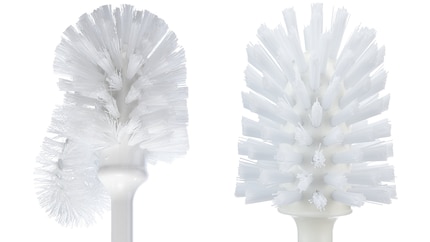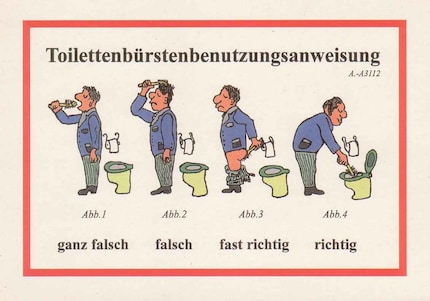
When your brush makes a mess
It disgusts me every time I move house. No, I'm not talking about the logistical problems, I'm talking about the toilet brushes, and more specifically the toilet brushes of the previous tenants.
The first toilet clean shows what kind of brush the previous tenants had: if there's still brown residue on the inside of the rim, they probably only had a single-headed brush. Sounds disgusting? Well, it is. That's why brushes like that should be banned! When I get the keys to a new flat, I don't run my hand under the rim of the toilet to check it's clean. With the right brush, this wouldn't even happen (if the former tenants of my current flat are reading this: I'm not writing this article because of you, you cleaned up really well). I don't even want to try and imagine what it looks like under the rim of the public toilet being cleaned with one of the blacklist brushes.

Comprehension
While scrubbing the toilet, I ask myself the following questions: why do people buy brushes without rim cleaners? More importantly: who develops/sells brushes without edge cleaners that are completely useless for cleaning? If it's for a decorative reason, I'd much rather opt for a potpourri in the bathroom than a stick with a brush at the end (for hygiene reasons, I always keep the toothbrush in the ice-cream cabinet anyway).
It looks like Galaxus has fallen for this too. A glance at the product range shows that most toilet brushes have only one head. It's mainly the designer products that don't have a special rim brush. And these things are super expensive too. When it comes to hygiene, function should really take precedence over appearance.
Xylospongium
You'd think toilet brush engineers would know how to clean under the rim. Especially as the w.c. brush is not new. Even in ancient times, people used the xylospongium, the precursor of the toilet brush, for secondary cleaning of their latrines. It consisted of a stick and a sponge. Obviously, not everyone knew how to use it properly. According to the Roman philosopher Seneca, a Germanic gladiator even killed himself by sticking the stick down his throat (I feel sick just thinking about it). The use of xylospongium has also been the subject of scientific debate. For example, it was long thought that it was used to clean one's bottom. Be that as it may, today most people, at least from our degree of latitude, know what the toilet brush is used for. Although some pictograms on toilets suggest otherwise.

Which toilet brush to choose
As you've gathered, I wouldn't recommend buying a toilet brush without an edge cleaner. If you can't do without a stylish brush right next to your toilet, you can buy a decent one that you'll only take out for cleaning the w.c. Where are you going to store it? Apart from in the broom cupboard, I'm disgusted at the very idea of storing it with the rest of my stuff. That's why it's better to choose function over appearance. I'll now reveal the other criteria I still take into account when buying a w.c.
brush.
Different brushes
Today's brushes generally have plastic bristles. The disadvantage of these is that - depending on the treatment - the bristles deform quickly. What's more, toilet paper and other residues often get caught in the bristles. Plastic bristles are also difficult to clean. As these brushes are relatively inexpensive, they can simply be replaced. This doesn't make them particularly environmentally friendly. In the past, bristles were made from root wood. Rootwood bristles excel where plastic bristles fail: they are recyclable and can be cleaned better. Silicone lamellae depart from the bristle principle. Nothing can get stuck in them and silicone is easy to clean. They are by far the most hygienic brush heads.
Handle
The handle should ensure a good grip. After all, who likes slipping while cleaning the loo and ending up with their hand in murky water? The handle should also be unbreakable. If you have to exert a little more pressure than usual, the stem should be able to withstand it. Otherwise you risk ending up with your head upside down in the bowl. The head should be a little flexible: after all, you also need to clean the bottom of the bowl.
Hold what they need to hold: the supports
With the toilet brush, what's the best way to stand out from the crowd? With the stand. Here, many manufacturers are completely off the mark and putting everything on design. But first things first. There are two basic types of stand: freestanding and fixed. The advantage of the free-standing stand is that you can move it around and replace it whenever you feel like it to bring a bit of freshness into the bathroom. You can't do that with a fixed support. But most fixed supports are raised. So you don't have to move them every time you want to vacuum or mop. Depending on the model, fixed stands are not always easy to clean. So you need to make sure that the manufacturer has also thought about the practical side.
Stands can be open or closed. Closed ones are not easy to clean. Because of the lid, unpleasant odours can be retained. What's more, with some closed models, the brush heads sit in dirty water. Would you like to soak in water that doesn't smell like roses? It's not at all hygienic, and makes no sense when it comes to cleaning, because dirt and bacteria are spread evenly. Open models are better. Once suspended, the brush heads can dry and drain. However, there are also open holders in which the brush heads sit in dirty water. If the drip tray can be removed for separate cleaning, then the designers have thought of everything.
Balance
If I take all these criteria into account, at Galaxus there aren't many potential toilet brushes left. The "designer pieces" are all out of the game. The few silicone models don't meet my other requirements. I would tend to choose a classic model and turn a blind eye to the environmental impact. Unfortunately, I have to do without a beautiful design, but at least I won't be leaving any unwanted gifts for the next tenants. Perhaps I could supplement my income by designing toilet brushes...
From big data to big brother, Cyborgs to Sci-Fi. All aspects of technology and society fascinate me.
From the latest iPhone to the return of 80s fashion. The editorial team will help you make sense of it all.
Show all